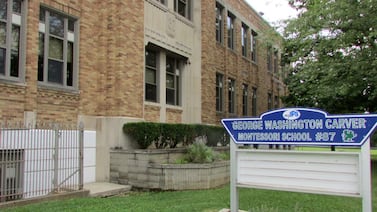When Eve Stotland called up organizations that manage homeless shelters this summer to find out how remote learning was going for students who lack permanent housing, she got the same answer from just about everyone.
“Right away leaders of all nonprofits said, ‘Not well,’” said Stotland, the program officer for education at the New York Community Trust, a charitable foundation.
The city announced this week that it will wire family homeless shelters with Wi-Fi, but that investment comes months after advocates and shelter operators began pleading with the city to improve internet connectivity for homeless students. Most shelters do not have Wi-Fi or have spotty connections for their city-issued iPads that use T-Mobile.
“Imagine being a teenager already set up with going to school in a crowded room with your mom and your siblings, and then you can’t get connected, and then you can’t hear, and your connection goes in and out,” said Myung Lee, CEO of Volunteers For America —Greater New York, which operates seven family and domestic violence shelters that serve about 1,000 school-age children. “Are you gonna keep trying? I don’t think so.”
As pressure on the city mounted amid a legal threat and several news articles, the city began sending technicians to some shelters to troubleshoot connectivity problems. But shelter operators and fundraising organizations had started taking matters into their own hands. Lee’s created an ambitious plan to raise hundreds of thousands of dollars to provide internet in every room at the shelters they manage. The New York Community Trust granted $850,000 to organizations working to improve remote learning for homeless students. And Women in Need, or WIN, which manages 11 shelters across the city, had raised money to purchase dozens of hotspots and devices for residents, establish a technical help desk, and wire community spaces with Wi-Fi.
Lack of internet access has long been a problem at city shelters, which housed more than 34,000 city students during the 2018-2019 school year, according to Advocates For Children New York. But the pandemic exacerbated the issues as more children relied on the internet to participate in remote schooling.
“I think what you see is shelters taking things into their hands because there is no choice and no help on the horizon,” Christine Quinn, president and CEO of WIN and former speaker of the City Council, said before the city’s announcement this week.
New York City’s Department of Social Services Commissioner Steve Banks held a call with shelter providers on Wednesday morning, laying out some details of the Wi-Fi plans, according to two providers. Officials told them the city will contract with two different companies to equip every unit in the city’s roughly 200 family shelters with Wi-Fi. But officials did not specify the total cost, how the city would pay for it, or how soon the work would begin, those sources said.
In order to solve connectivity problems before the Wi-Fi comes, technicians will troubleshoot issues with city-issued iPads within 24 hours of an issue being reported at a shelter, according to a City Hall spokesperson, who said more details on the plan are forthcoming.
In a statement shortly after the mayor’s announcement, Quinn said she hoped de Blasio will follow through on the promise “because no provider should have to do this alone.”
After schools shuttered due to the coronavirus crisis, city officials purchased and delivered 350,000 internet-enabled iPads for families without devices and internet. It has plans to purchase 100,000 more as many students remain without a proper device, with priority going to students living in temporary housing. But without reliable Wi-Fi, advocates and fundraisers heard stories of families struggling to help their children log on, often with no success.
In August, after Stotland’s conversation with shelter providers, the Community Trust granted a total $850,000 to HELP USA, WIN, BronxWorks, and CAMBA for projects to improve remote learning for children in their shelters, including plans to widen access to the internet. (New York Community Trust is a funder of Chalkbeat.)
“Unfortunately the resources of the Trust don’t permit us to make a systemwide fix,” Stotland said. “What we’re able to do is support alleviation of the problem.”
WIN, meanwhile, used some of that money to establish its own IT help desk for its shelter residents, after many clients couldn’t easily reach the education department’s help desk. Separately, it raised $134,500 to purchase hotspots, iPads, cell phone plans for some of those iPads, and 1,500 sets of headphones for children who needed them. The organization spent another $130,000 — about 40% of it fundraised — to establish Wi-Fi connection in their shelters’ community rooms. Half of that work was done before the pandemic, but the rest of it was fast-tracked as remote learning started.
At the same time, WIN was searching for a funder that would help foot the estimated $300,000 annual cost of wiring all of their shelter units with Wi-Fi, Quinn said. They had no luck. In August the organization sent a scathing letter to the city pleading for more remote learning support for children in shelters, many who felt forced to attend in-person school, the letter said.
Similarly this month, Volunteers for America of Greater New York launched an ambitious fundraising effort to wire every unit in its seven shelters. They estimated an initial cost of $890,000.
The group had raised about $30,000, which they used to create a “learning pod” in one shelter’s community areas, where families can sign up to use Wi-Fi, and children are separated by plexiglass dividers. Since the city’s announcement, which the organization applauded, Lee has decided to cancel the fundraising effort in hopes that “the city is moving quickly on this.”
But plenty of questions remain.
“We’re glad that after months of raising concerns, the mayor has committed to ensuring students living in shelter have the connectivity they need to log on to school,” said Randi Levine, policy director for Advocates For Children New York. “We are eager to hear more details, including a timeline, as we continue to hear from families in shelters who are continuing to miss out on school because they can’t get online.”







